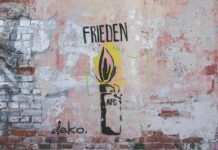Antoine Pesnes view of Kietz in Bad Freienwalde, the neumärkische or landscape looks like a branch of Arcadia. The Bayou of the river, where the village is located, is nestled between pastures, bushes on a hill with thatched-roof farmhouses. In the foreground elegantly dressed idle are sorted goers to small groups, a youth embracing a girl, another plays his beloved guitar. On the finished oil Painting in the castle of Oranienburg, the Green is compacted to the shore, the forest, the village scenery to the left extended, the personnel is reduced, but here, in the sketch with Rötelstift and brush in grey, the scene was still the fresh appeal of the idea. It is a Prussian utopia, this Idyll in the summer of 1745, the summons in the middle of the second Silesian war, the peace, the mood of the pre-war period. Twelve years later the painter died, and Arcadia was history.
Andreas Kilb
feuilleton correspondent in Berlin.
F. A. Z.
Pesnes Kietzer sketch of the French master, and the copper engraving Cabinet shows in his exhibition hall at the Kulturforum in Berlin is now hanging in an exhibition with a good ninety drawings. Not all painters are represented here, have created their life’s work in France, but almost all of them have a slightly-handed virtuosity, the expression of a national character, not is if so but the product of a shared historical experience. In 1648, the Académie royale of painting and sculpture, which took the training of artistic talents in the Hand, and with the founding of the Académie de France in Rome in 1666 their influence to Italy expanded originated in Paris.
The Typical in the Individual
A graphite drawing by Charles Nicolas Cochins of 1763 demonstrates how the operation worked: on the Right, the youngest pupils in the Copy of classic Nude paintings practice, while the older ones may draw in the middle after sculptures and the Advanced moves on the left edge of the picture, a living model. Three-quarters of the shown in Berlin artists of the academic institution and your area, so that one may speak without Exaggeration of a Academy exhibition. Dagmar Korbacher, the curator and new Director of the kupferstichkabinett, preferably, however, a less officious title and refers to your presentation, prefer to “Rendezvous”.
Like any good overview, look, this reveals the Typical in the Individual. The French love, at the latest, since Lorrain, the Architectural, the landscape and the stone architecture and landscapes; for the clouds and shadows of the low countries, they have little left. Capriccios of exotic and mythological materials are more than biblical history (even if Boucher is a “sermon of John the Baptist in the desert” in the style of a Rococo-throws Pontormo on a sheet). The epitome of the French weakness for decorative elegance Nattiers giant format “Quos ego”, based on 62 times 98 centimeters of the God Neptune on his four-in-hand with the nymphs, tritons, and cupids in a trumpet-blowing angels, is crowned with a magnificent frame. The drawing is a lost ceiling paintings from the Palais Royal, but the Cabinet pieces like this were also exhibited as independent works of art in the Salon.
At the other end of the scale of Expression Jean-Baptiste Oudrys chalk sketch of a Porcupine, which was created after a Ölstudie of the animal painter Pieter Boel, but so alive, as if it were drawn on a living object. For Nattier as for his return, you will get the most momentum from your Subject. So you can feel even in Charles-Joseph Natoires views of the Villa d’este and the ruins on the Palatine hill, always the Wind through the trees. The silence of Rembrandt’s the French painters borrowed, you live in a sounding universe, in which things umwirbeln each other as the costumes and wigs on the Strength of the sun king.
Five sheets of Watteau, the, in the evening red is always bather “Italian troupe of actors” to see in Berlin. Most of them were only acquired in the last century, the copper engraving Cabinet under Max Friedländer and his followers supplemented the collections on schedule. The most important turning point in the history of the French Department was in the year 1886, as a 2400 drawings from the collection Destailleur, after a long dispute at the arts and crafts Museum, the art library has the largest such population in Germany. Better than that of the copper engraving Cabinet, he can’t be, because what the exhibition shows is hard to beat. Clouet, Vouet, Poussin, Lorrain, Fragonard, Liotard, Lancret, Rigaud, Callot, they are all there, and even small masters such as Jean-Michel Moreau to Shine with Top songs. The “farewell to the Briseis of Achilles” sent by the collector and publisher Lagarde once to Goethe, in order for this check the quality of the drawing. The Poet gave his blessing.




